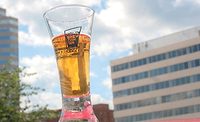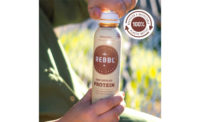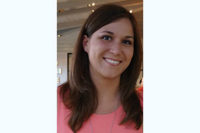![]()
New Label Options Take Beverage packaging to the Next Level
By LAURIE RUSSO
Beverage labeling, once
almost an afterthought, has come a long way. No longer a device used for
simply naming the product and listing its ingredients, labeling is now an
art form; a promotional tool that not only tells a story, but sends a
valuable come-hither message to increasingly demanding consumers. One such label, the shrink-sleeve, can seemingly turn
a beverage package into... well, anything.
“I think the beverage industry has realized that
shrink labels are the thing of the future,” says Sharon Lobel,
President of Seal-It, Farmingdale, N.Y. “They make products pop off
the shelves, look more appealing... you can make a bottle look like
anything you want it to. You can make it look like wood, metal, or etched
glass.”
Seal-It — whose eye-catching works can be found
on products such as In-Zone’s BellyWashers and TummyTicklers, as well
as Clearly Canadian — is, in fact, working on a process that makes
glass look etched.
“Etched glass is very expensive,” Lobel
notes. “So we have a new kind of gold ink that makes anything look
like gold-stamped, etched glass. You can even put it on plastic or PET
bottles.”
There are other benefits as well, she says. “You
have that gloss, that pop, that high-end look that paper labels just
can’t give. It sells the product, makes the consumer at least try it.
And you also have 360 degrees of real estate.”
Some use the additional real estate to fit more
graphics in, says David Seuss, vice president of sales at Color Craft,
Memphis Tenn., while others use it to make the label multi-lingual. Color
Craft will shortly open a new 24,000-square-foot facility specifically for
this market, featuring a 22-inch, 10-color press that will print roll-film
labels, roll-shrink labels, shrink-sleeve labels and flexible packaging.
“Our primary focus is the shrink-sleeve label,
which enhances shelf appeal and allows for line extensions,” says
Seuss. “A lot of companies are just taking existing packaging and
putting an extension on it, so the runs are large, but not as large as
you’d find with, say, a normal Coca-Cola 12-ounce can. There are
areas they’re focusing on to get shelf appeal, while still
maintaining their traditional line while selling promotional items.”
Richmond, Va.,-based Alcoa Flexible Film Division,
which provides labeling for Nestlé’s Nesquik, Rolo and
Coffee-mate liquids, has seen tremendous growth — some new beverages,
and some relabeling old products. Says Terry Copenhaver, commercial manager
for Shrink-sleeve Packaging, “The immediate value of the
shrink-sleeve is the high-impact, high-gloss, brightly colored shelf
appeal, plus the amount of top-to-bottom coverage it provides.”
There’s that real estate again. But there are
other advantages, she explains, such as speed, advances in ink and
substrate technology. “Higher speed application equipment for
shrink-labels is an issue,” she says. “One problem for beverage
manufacturers was that the speed of their wraparound labels was so high,
and they didn’t want to go to slower speeds” She notes
they’re now up to 700 to 800 bottles a minute... sometimes 1,000,
depending on the bottle size.
“We’re also seeing the impact of
thermochromatic inks; we’ve done flip-inks, which change colors when
you move the product back and forth,” she says.
Copenhaver says a fairly new substrate, oriented
polystyrene (OPS), “gives a better yield on the film, and it’s
more economical. Overall, the cost of labels is coming down.”
Baltimore, Md.’s Gamse Litho runs the gamut from
foil/metallized paper to shrink. Joan Ziegler, marketing director and key
accounts manager, says “the most interesting thing for us would be
the advancement of the synthetics into the clears. The white opaque
synthetics have been out for a while now, but the arena has been expanding
into cold glue availability.” She cites Cadbury-Schweppes, which has
used it on its Mistic bottles, Honest Tea and Veryfine as examples of
companies looking in that direction.
Organic, she says, is another big area. “There’s a whole niche of
consumers who are not interested in seeing synthetic packaging for their
beverages,” she says. “They need to
know it’s recyclable. [Synthetic supplier] ExxonMobil is looking into
ways to address this.”
The Nantucket Nectars Organics package, she recalls,
presented a challenge. “We went to the mill and worked with them to
refine a substrate [named Chesapeake Laid] that they could run at 700
bottles a minute and still show the ‘fiber’ appearance they
were looking for,” she says. “It gives that real earthy feel.
The wine industry is coming out with a lot of single-serve and looking for
an organic feel as well.”
Pressure-sensitive film is the main focus of Spear
Systems of Cincinnati, Ohio. Says Dan Muenzer, director of marketing,
“Beverage is a very competitive marketplace, so brands are looking
for every possible advantage. Pressure-sensitive labels allow you to create
some really dynamite-looking packages for differentiation on
shelves.”
Historically, he notes, the first beverage to use the
technology back in the ‘90s, Clearly Canadian, paid a significant
upcharge for it. “It worked for them,” he says, “but the
costs limited use to premium and specialty items. As the technology has
evolved, it’s become so affordable that Budweiser has been able to
convert to pressure-sensitive technology.”
He believes the speed of label application is a big
piece of expanding the use of pressure-sensitive, and confirms that
Spear (whose clients include Coca-Cola, Pepsi, Cadbury-Schweppes,
Anheuser-Busch, SAB Miller, Heineken, Interbrew and Carlsberg) now has
equipment capable of more than 1,000 bottles per minute, “allowing it
to go on the fastest of all beverage lines, so they can label right in line
with filling. Before, they had bring in bottles that were already
labeled.”
Muenzer expresses a touch of doubt for the future of
paper for most major beverage categories, “because graphically you
can’t do as much as with film, and film is far more durable. Paper
labels can’t take the same abuse, like getting wet, hot or
scratched.” In the broader sense, he says, paper still dominates the
market, but in terms of beverage, there’s more film than paper.
However, he concedes, “wine has traditionally used paper, and they probably won’t go to film because there are
still things you can do aesthetically with paper that you can’t do
with film.” BI



